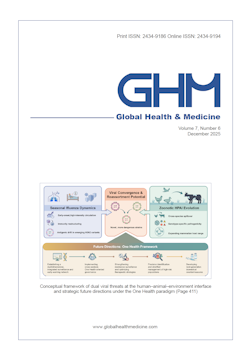Global Health & Medicine 2021;3(3):134-141.
Epidemiology of cardiovascular disease and its risk factors in Korea
Kim HC
Cardiovascular disease (CVD) is the leading cause of death and a major contributor to disability worldwide. Currently, Korea is among countries with the lowest CVD mortality rates, and the age-adjusted CVD mortality rate is still decreasing. However, depending on the CVD type, the mortality and incidence trends vary. Without agestandardization, cerebrovascular disease mortality peaked in 1994 (82.1 per 100K) and continued to decline until 2018 (44.7 per 100K), while heart disease mortality recorded the lowest level in 2001 (44.9 per 100K) then increased again until 2018 (74.5 per 100K). Age-standardized mortality rates showed different trends: both cerebrovascular disease and heart disease mortality rates have declined over the past few decades, although the rate of decline varies. Based on the National Health Insurance claim database, the numbers of hospitalization for cerebrovascular disease and ischemic heart disease are increasing, but the age-standardized hospitalization rates are decreasing. Unlike other types of CVDs, heart failure is rapidly increasing in both mortality and hospitalization rates regardless of age-standardization. Seventy percent of Korean adults have at least one risk factor, 41% have ≥ 2 risk factors, and 19% have ≥ 3 risk factors including hypertension, diabetes, hypercholesterolemia, obesity, and smoking. Exposure to multiple risk factors increases with age, with 65% of senior citizens over 70 having ≥ 2 risk factors and 34% having ≥ 3 risk factors. As the elderly population, especially those with multiple risk factors and chronic disorders, is increasing, the management of this high-risk group will be an important challenge to prevent CVD in Korea.
DOI: 10.35772/ghm.2021.01008







